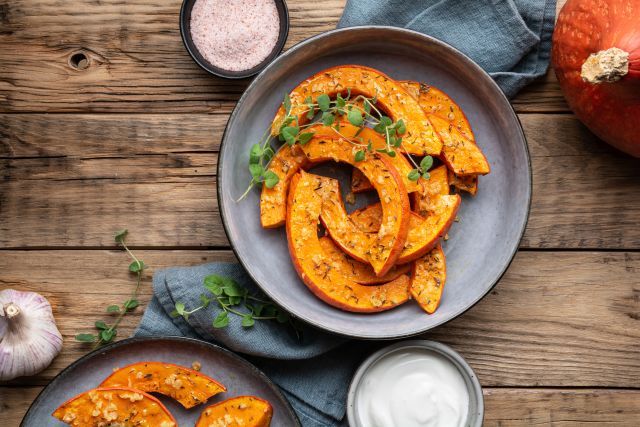Updated on April 18, 2023.
Every fall, pumpkins flood markets and grocery stores, waiting for their carved faces to adorn porches and front stoops. But if you only use pumpkins as decoration, you’re missing out on one of the healthiest fall fruits.
Nutrient-dense and filling, pumpkins contain fiber, essential amino acids, and healthy unsaturated fats. They also boast a range of compounds with antioxidant and anti-inflammatory properties, providing support for your heart, eyes, immune system, and more.
Vision booster
Pumpkins are rich in vitamin A, an essential nutrient for healthy eyes. The daily recommended amount of vitamin A for adults is 700 micrograms (mcg) for women and 900 mcg for women. One cup of pumpkin contains a hefty 426 mcg.
Pumpkin also contains lutein and zeaxanthin, also found in yellow and orange foods like peppers, carrots, and corn. These carotenoid antioxidant pigments can help protect the eyes from damage caused by blue light, which is emitted by devices like smartphones and computer screens.
The antioxidants in pumpkin also generally support healthy vision. A 2021 article published in the journal Antioxidants found that carotenoids may reduce the risk of age-related macular degeneration (AMD) and improve vision for people with existing AMD.
Hearty heart helper
Getting plenty of fiber in your diet helps reduce cholesterol levels. Fiber helps move food through the digestive system more efficiently, leaving less time for cholesterol to be absorbed in the bloodstream. Most experts recommend that women get at least 25 grams (g) of fiber a day and that men get 38 g daily. One cup of canned pumpkin has about 7 g of fiber.
Potassium is also a key nutrient for heart health. It’s been shown to help reduce blood pressure, particularly among people with hypertension. One cup of pumpkin has 340 milligrams (mg) of potassium, about 13 percent of the recommended daily intake for women.
Blood sugar tamer
An enzyme in the body known as a-glycosidase is responsible for breaking down complex carbohydrates, which increases glucose levels in the blood. But compounds in pumpkin may slow down this process, keeping glucose levels steadier over time, according to a 2022 literature review in the journal Plants.
Cancer risk reducer
Pumpkin seeds and their oils contain compounds known as terpenoids and triterpenoids that are believed to have anti-cancer properties, and studies have linked pumpkin seeds and pumpkin seed oil with lowered risk of breast, rectal, lung and prostate cancers. Among the many mechanisms that may be at play, some animal research also shows that the plant estrogens in pumpkin may influence estrogen and testosterone, hormones which drive many cases of breast and prostate cancer in humans.
Sweet, savory, and healthy
When enjoying pumpkin, it helps to think outside the realm of pumpkin-spiced drinks that proliferate in the fall. You can eat pretty much any part of the pumpkin, and every part is packed with nutrients. Here are some pumpkin preparations to get you started:
Pumpkin puree
The best pumpkins for eating are generally smaller (and sweeter and creamier) than the larger jack-o'-lantern-style fruits. The flesh from whole pumpkins can make a surprisingly good addition to savory foods like chili and macaroni and cheese.
To whip up a fresh purée, start by cutting your pumpkin in half, scooping out the strings and seeds, then cooking using one of these methods:
- Microwave: Place the halves cut-side down on a microwave-safe plate and cook on high for 15 minutes or until tender. When cool enough to handle, spoon out cooked insides.
- Boil: Cut the halves into cubes, place in a saucepan, and cover with water. Bring to a boil and cook until tender. Drain, cool, and peel each piece.
- Bake: Place the halves cut-side down on a foil-lined baking sheet and bake for an hour at 325 degrees Fahrenheit. When cool enough to handle, spoon out the tender insides.
Then, mash or purée the cooked flesh in a food processor or blender. You can save the product for a pie, soup, or muffins, or add a little brown sugar and cinnamon and serve it right away for dinner. Any unused purée will keep in the fridge for five days or in the freezer for up to six months.
Save the seeds
Pumpkin seeds are loaded with iron, zinc, phosphorous, magnesium, protein, vitamin K, and phytosterols—plant compounds that help lower cholesterol, reduce the risk of certain cancers, and support your immune system.
You can find dried, raw, hulled pumpkin seeds (the green kind) in most grocery stores. These make great toppings for cereal and can add some crunch to baked goods.
You can also grind the green seeds into powder to blend into smoothies, sprinkle onto oatmeal, or bake into muffins—or find pre-ground pumpkin seed flour in specialty stores.
If you’re cooking up a whole pumpkin, you can also turn the whole seeds (the kind that still have their thin white shells), into a tasty, healthy snack or salad topping. Here’s how:
- Rinse the seeds under cold water, removing any pulp or strings.
- Place on a cookie sheet, drizzle with olive oil, and shake or stir until the seeds are well coated.
- Sprinkle lightly with salt and bake at 325 degrees Fahrenheit for about 25 minutes.
- For extra flavor, season with a little Worcestershire sauce, lemon juice, garlic salt, or cayenne pepper.
Don’t overlook the skin
Even if you save your pumpkin seeds and puree the flesh, you might trash the leftover rind—but that skin is a great source of fiber. You can make simple pumpkin “chips” by peeling pieces of skin off roasted pumpkin, tossing them in olive oil, salt, and seasonal spices like cinnamon and nutmeg, and baking for about 10 minutes at 400 degrees Farhenheit until crispy and delicious.






